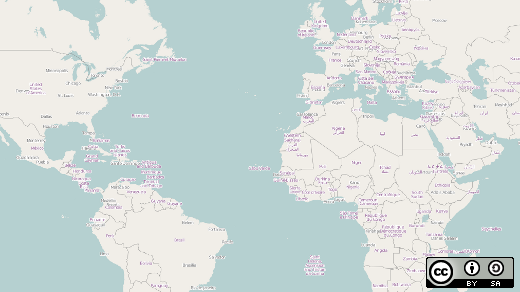Down what appears to be an alley just large enough to drive a delivery truck, Mapbox's Washington, DC office is tucked into its surroundings much like their contributions to the open source cartography world: integrated without shouting. Only their trademark hexagon globe sign will let you know that you've arrived at the proper location. Once inside the unassuming office, you'll find yourself standing in the middle of their work zone. Making their home in an old garage, the first floor is full of computers and people working diligently to churn out tools and data to be used by the world's masses, all in what can only be described as a silence found only in a library. What's being produced here affects many of the mainstream and up-and-coming mobile applications found on many a smartphone.
Mapbox makes it easy for anyone to leverage the work of the hundreds of thousands of open source cartographers from all around the world who make their work available on OpenStreetMap (OSM). Contributing back to the community is part of their mission as well. With several FOSS projects in their inventory, Mapbox has already made a serious impact in the OSM community. Their efforts revolve around two development areas: parsing data and contributing data.
Developers at Mapbox are working on routing engines, APIs for their data, and libraries that make it easy to make the treasure trove of cartography data work. These tools generally operate on the back-end to parse data and make it available to the end user via an application or website. They're also working on tools to allow easy creation and maintenance of OSM data. The iD tool, for example, allows people to add points of interest, trace satellite imagery, and interact with all facets of OSM data. While features are being added to help new cartographers add their data to the map, iD is a very powerful tool that can be used as the primary editing software by experienced mappers as well.
Mapbox was started by OSM mappers who felt a need to fill a gap in the market and get OSM data into people's hands. And while they do use some proprietary sources of data, their bread-and-butter data comes from the OSM community. Beyond the business, Mapbox's CEO Eric Gundersen says that he feels that open source licensing of data is only going to become more important to companies in the future. Mapbox's maps are generally being used for end-users' benefit, so any additions to the OSM data could provide a service to everyone. And because the license used with the OSM data is so much more open, businesses and individuals can leverage those resources much easier than other mapping solutions.
Of course you can't think of online mapping and not think of Google's mapping solutions, Google Maps and Google Earth. Their data is license-encumbered, and while they do allow the public a way to add information to their maps, the result isn't a straightforward, instantly available change as you might expect. In contrast, information that is added or modified in OSM's databases is generally available in Mapbox products within ten minutes. OSM also enjoys a larger contributor base with more than 20,000 people contributing each month.
It's also important to recognize that the contributions to the OSM community are generally being done using Free and Open Source Software (FOSS). According to Alex Barth, the lead of Mapbox's data team, most, if not all, software used to work with the data is FOSS, including iD and JOSM. And if people aren't running Macs, they are using some variant of Linux to create their works. All servers powering their products are Ubuntu.
Cartography is becoming more important than ever, and now its never been easier to get a map into someone's hands. Doing it the open source way only adds value to that information. It's exciting to find more commercial entities leveraging the power of open source to not only power their dreams but also help others achieve theirs.







1 Comment